September 17, 2008 at 12:41 am · Filed under Travel / lifestyle musings
 Today in the grocery store, in Kanab UT, Eleanor discovered treacle in a can.
Today in the grocery store, in Kanab UT, Eleanor discovered treacle in a can.
Now, you might wonder why treacle can be found in a town with only one pizza restaurant and a pair of small grocery stores. I’ve never even seen treacle before. I’ve only read of it, mostly in references to being “treacly” meaning overly sentimental.
I always thought treacle was some sort of sweet syrup, like molasses, and in fact that is true, but apparently there is a treacle pudding as well. And, like all good things, you can get it in a can courtesy of the Heinz company.
But why here in Kanab? Treacle sponge pudding is the sort of specialty food item that would be hard to find even in a major metro area. People actually order it online from website like English Tea Store, and UK Goods. We can only assume its presence is the result of the influence of huge numbers of British citizens who miss the comfort foods of home while they are exploring our national parks. The “British Invasion” has never stopped since the Beatles first landed here, and this is proof.
So of course Eleanor bought a can. She says it is because of references in the Harry Potter books that she chose it, and bypassed the Spotted Dick (another British pudding). I’ve had Spotted Dick (insert joke here), and it’s actually quite good if you can bring yourself to ask the waiter for it. Best to do it in England or Wales, where nobody will laugh.
Today while getting a haircut at the only barber shop in town, I heard a bit of local lore from the barber. If you are in Kanab, I recommend this place because he gave me a good haircut and a good chat. (He says the haircut is $2 and the chat is $10.) As I mentioned yesterday, a lot of western films have been shot in this area. He himself was in a couple, as an extra. Once he was even dressed up as an “Indian” and rode bareback amongst a crowd of other extras.
He also told me that Robert Redford was here for a couple of movies way back when, but he doesn’t shoot movies here any more. Why? Because of a coal mine. Apparently there is a lot of high-quality coal under the Grand Staircase-Escalante National Monument. Locals wanted it mined and burned in a power plant, but a long-time battle prevented this until President Clinton resolved it by declaring the land a national monument.
But before that happened, in the 1970s, Redford entered the debate on the side of the environmentalists who wanted to stop the coal mines. Kanab residents hung him in effigy, and not surprisingly, he took it a bit personally. “I tell people, it’s never a good idea to hang someone in effigy,” said my friendly Mormon barber … and I had to agree.
Just about a quarter-mile from our campground is another Grand Staircase-Escalante Nat’l Mon. visitor center. Apparently there are several, each with a different emphasis. Looking for something to do in the afternoon besides work, we went over there and discovered that the BLM national monument has a “Junior Scientist” program much like the Junior Ranger program of the National Park system. So now Emma has that to occupy her in addition to her usual home schooling. One thing she’s learned already is that there are a lot of dinosaurs in the monument. Even the scientists have been surprised by how many have turned up, and now say that the monument has the highest concentration of dinosaur fossils in the world.
All of these random items combine to one conclusion: Even in a tiny outpost in the desert like Kanab, there are things to learn and unexpected experiences if you just dig a little bit. Kanab is such a small town that we can drive from end to end in about five minutes, and that includes the stoplights. We’ve seen virtually every block of town now, and it didn’t take long. But digging into all the stories and characters is like trying to hike every canyon hidden in the plateaus above us. We could spend years here and I think there would still be surprises ahead.
September 15, 2008 at 7:27 pm · Filed under Eleanor's posts
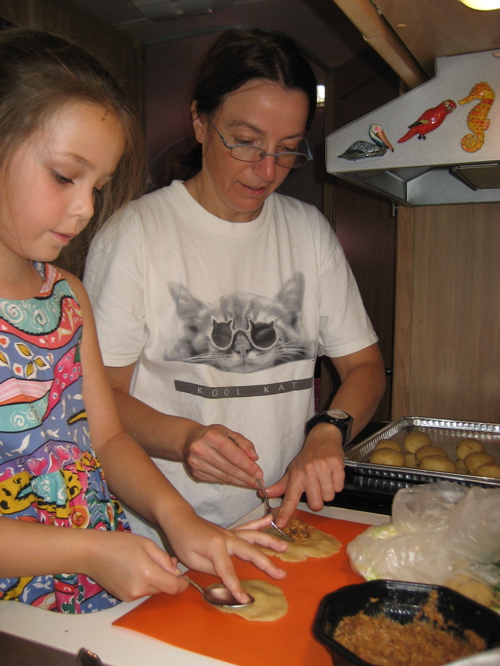 Inspired by the moon, Eleanor writes one of her rare blog postings:
Inspired by the moon, Eleanor writes one of her rare blog postings:
Today is the zenith of the Harvest Moon. I have always been intrigued with the moon. I have the date & time of each full & new moon recorded on my lap-top calendar. The Harvest Moon is extra special. Since pre-history, Cultures all over the world celebrate it through dances, songs, special foods, prayers, and offerings. I thought I would do some internet searches to find out more about it, and do some celebrating of my own this year.
One of the things I learned was that for the Chinese mid-autumn moon festival, it is women who honor this holiday. I read:
“On the full moon of the eighth Chinese lunar month, women celebrate the Moon. This is the beginning of the yin part of the year, when the dark takes precedence over the light, and the Moon is the symbol of yin energy, which also includes water, women and night. In the old Chinese agrarian system, autumn and winter were the women’s seasons.”
(for more info, go to http://www.schooloftheseasons.com/midaut.html)
I thought it would be fun for Emma and I to do our own small celebration.
 This morning we made full moon cakes.
This morning we made full moon cakes.
We are only eating things that are round today.
We’ll watch the moon rise.
Tonight we will play a game called “Capturing the Moon,” where we will try to catch our reflection in a bowl of water.
It’s not much, but it’s fun and it gives us a little more insight & understanding into something that is greatly celebrated.
September 15, 2008 at 4:27 pm · Filed under Places to go
Acting on a tip from a blog reader, we drove over to Pipe Spring National Monument in nearby Fredonia AZ. It’s only about 25 miles from Kanab, but with all the BIG national monuments and parks around, we might easily have overlooked it.
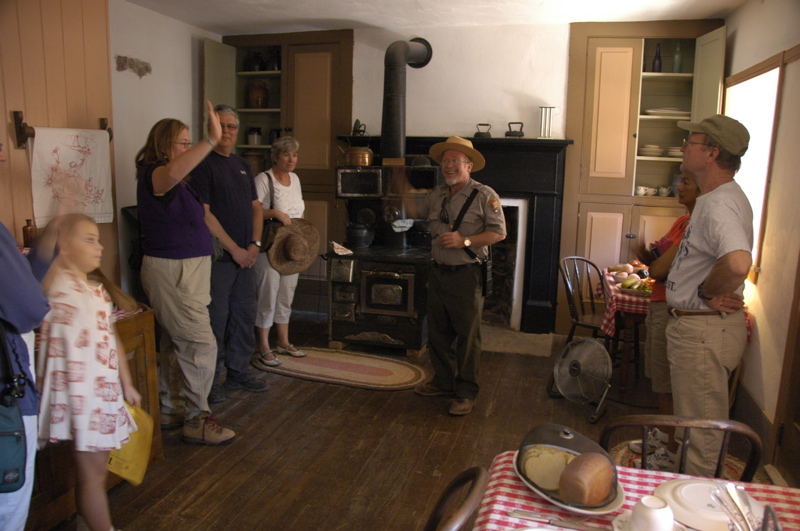 The site is located in the middle of a small reservation belonging to the Kaibab band of the southern Paiutes. It jointly celebrates the life of early Mormon settlers and the native Americans who lived on this land for untold years before. The outside displays include structures built by the Mormons, and inside the museum are interpretive displays about the Paiutes and their gentle, earth-friendly philosphy.
The site is located in the middle of a small reservation belonging to the Kaibab band of the southern Paiutes. It jointly celebrates the life of early Mormon settlers and the native Americans who lived on this land for untold years before. The outside displays include structures built by the Mormons, and inside the museum are interpretive displays about the Paiutes and their gentle, earth-friendly philosphy.
The Paiutes believed that “all things are placed on this land with the breath of life, just as humans,” in the words of a tribal elder. “This land is considered to be their home, just as it is for man, and it is taught that one must consider that rocks, trees, animals, mountains, and all other things are on the same level as man. Each has a purpose in life, and the one who created every living thing on this earth placed all living things here to interact with one another … It is said that the plants, animals, and in fact, everything on this land, understands the Paiute language, and when one listens closely and intently enough, there is affirmation and a sense of understanding.”
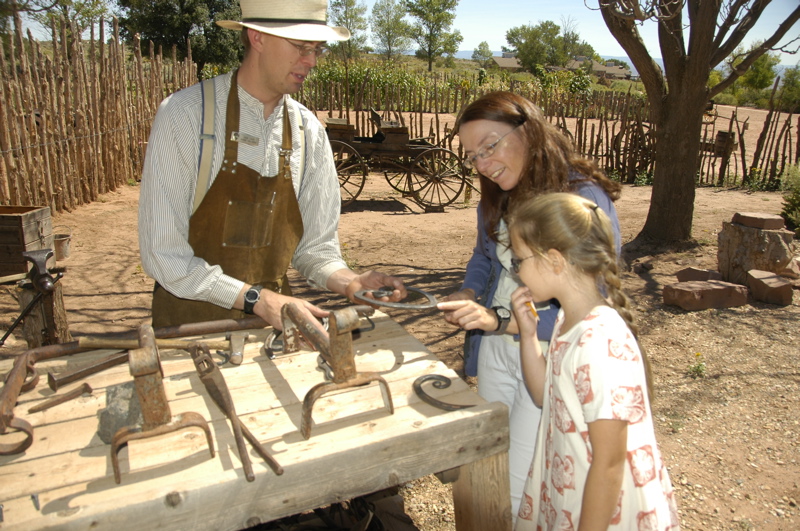 The philosophy of the European settlers was quite different. They set out to tame the land, populate it with large families, and convert the natives from “aimless wanderers” to farmers. They were not successful with the natives, who were already struggling with loss of traditional lands and encroachment, and wanted to retain their heritage. But the Mormons did successfully set up a “tithing ranch” which used a barter system for mutual benefit of their community, and the remains of this ranch are the centerpiece of Pipe Springs National Monument.
The philosophy of the European settlers was quite different. They set out to tame the land, populate it with large families, and convert the natives from “aimless wanderers” to farmers. They were not successful with the natives, who were already struggling with loss of traditional lands and encroachment, and wanted to retain their heritage. But the Mormons did successfully set up a “tithing ranch” which used a barter system for mutual benefit of their community, and the remains of this ranch are the centerpiece of Pipe Springs National Monument.
 Being a small park with a lot of dedicated staff and volunteers, the interpretation was excellent. Three of them spent quite a lot of time with us, answering questions and giving demonstrations. One ranger gave me a ton of tips on vegetable gardening in the southwest desert, which will be useful for Tucson once we settle in there. The park maintains orchards and vegetable gardens full of heirloom plants, and they share the produce freely with anyone who visits. I collected a package of beans and other seeds — we’d like to try growing some of the traditional crops in our garden too.
Being a small park with a lot of dedicated staff and volunteers, the interpretation was excellent. Three of them spent quite a lot of time with us, answering questions and giving demonstrations. One ranger gave me a ton of tips on vegetable gardening in the southwest desert, which will be useful for Tucson once we settle in there. The park maintains orchards and vegetable gardens full of heirloom plants, and they share the produce freely with anyone who visits. I collected a package of beans and other seeds — we’d like to try growing some of the traditional crops in our garden too.
I’ve discovered that Kanab, UT (our present location) is an excellent base of operations to visit the national parks. Bryce Canyon NP is about 85 miles north, Zion NP is 60 miles west, and Grand Canyon’s north rim is about 75 miles south. Pipe Spring NM is 25 miles southeast, too. We’re sitting just a few miles north of the Arizona border (Karen) with all the conveniences of a small town, with wifi everywhere, inexpensive full-hookup camping, and nice views of the red rock mesas.
They call Kanab “Utah’s little Hollywood” because of all the westerns that have been shot here. Downtown there are plaques commemorating the movie stars who came here and in some cases lived here part-time. There’s not much settlement around Kanab, so there’s plenty of scenery to be had, and Kanab is happy to supply the rest. It makes a decent spot to hang out for a while between adventures, or a good spot to come back to after a day of ATV riding or hiking out in the country.
Grand Canyon’s north rim is less visited than the south, but there are also fewer camping choices near the rim, so you still need reservations. Our reservation is for Thursday, which means we’ll be parked in Kanab for a while. We are considering a day trip into Zion beforehand, but really, I should keep at the computer most of the time we are here. Most likely we’ll just stay and enjoy the fine late-summer weather (80s and sunshine every day).
September 13, 2008 at 5:21 pm · Filed under Where's George?
Back in mid-August, following a $1500 round of repairs at Airstream, a faithful blog critic who goes by the alias of “Dr. C” suggested that we “pass the digital hat” for donations. This was intended to help us with the financial cost of traveling around and tantalizing you with blog entries about all the fun we are having.
Dr. C’s comment was well-intended but I was pretty sure we wouldn’t be inundated with money, so I responded by saying that we already get a lot of non-financial support from blog readers, and that was good enough. I further said that if anyone felt blog readers could do more, they should write their suggestions on the back of a $20 bill and mail it to me.
 Well, somebody actually did that, and so I got the $20 bill pictured at left when we picked up our mail in Kanab yesterday. The letter came anonymously, with a postmark of Troutdale (Oregon? Virginia?) over a “Princess Aurora” postage stamp. At least, I think it was Troutdale — the cancellation was not clear.
Well, somebody actually did that, and so I got the $20 bill pictured at left when we picked up our mail in Kanab yesterday. The letter came anonymously, with a postmark of Troutdale (Oregon? Virginia?) over a “Princess Aurora” postage stamp. At least, I think it was Troutdale — the cancellation was not clear.
Despite my severe disappointment that the sender ran out of fifties, I appreciate the thought and want to put the bill to good use. I have registered it at Where’s George.com, a website that — believe it or not — tracks the progress of US currency as it is spent.
The system depends on people voluntarily going to the website and entering information about the bill, when they get it. To alert people to the trivial importance of doing so, along the top edge of the back of the bill I have written “Please track me! at wheresgeorge.com”.
Let’s see if anyone actually does. You can follow the progress of the bill by following this link. If there are updates posted online, I’ll get an email too, and I’ll mention it on the blog.
Of course, to get the bill started in circulation, I need to spend it. It’s my responsibility and I intend to rise to the occasion soon. I think we may try one of Kanab’s little restaurants on Sunday. Hopefully the bill will begin its own Tour of America soon and not end up stuffed into a mattress somewhere, and we’ll be able to see where this thoughtful donation goes from here.
September 12, 2008 at 5:21 pm · Filed under Tips & Ideas
We’ve moved on from Bryce Canyon to Kanab UT for a few days. It’s time to resupply the ship and do some serious work.
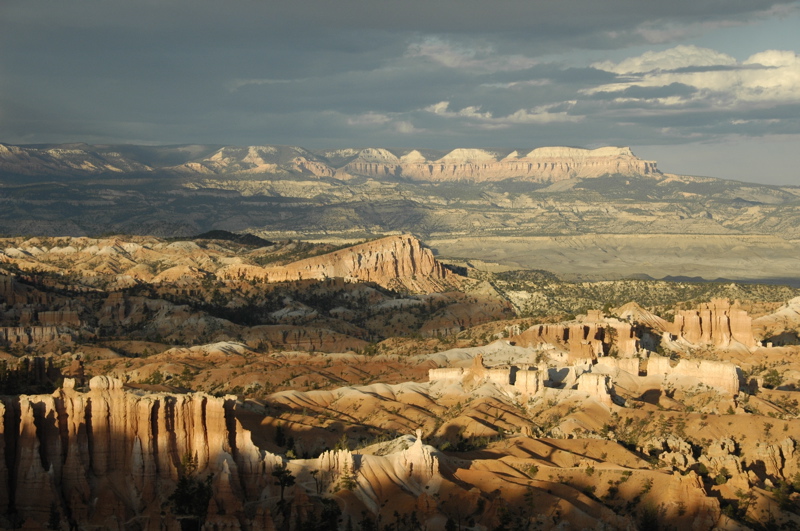
Our last hike in Bryce yesterday was terrific, and I’ll have photos uploaded to Flickr soon. But there’s no getting away from the fact that the park is crowded. We rarely had solitude, which we’ve come to expect often in other national parks. We would have had to hike many miles from the rim to get the sort of peace that is available in abundance at less popular parks.
Looking at the park service’s report on 2007 visitation yesterday, I was curious to see some of the least-visited parks that we’ve been to. Given that we like quieter places, I was wondering which ones we’ve missed.
Turns out we’ve missed a lot of them. Of 360 parks in the report, the least-visited one we’ve been to is Fossil Butte National Monument (Wyoming), ranked #314 overall with 19,853 visitors. I remember that visit well. Emma got a lot of attention from the rangers, and only a handful of people walked into the visitor center while we were there. It was also memorable for the broken lug stud later that day.
Hovenweep NMON in Utah ranks #305 in the list. We loved that place for its solitude, the unique Ancient Puebloan ruins, and the beautiful campground.
Before we started full-timing, we visited St-Gaudens National Historic Site in New Hampshire (#303), and I remember parking our 1968 Airstream Caravel on the grounds (there’s no camping) for the afternoon. It’s a nice site, attributed to a famous artist, but slightly obscure.
Vermont’s only national park is Marsh-Billings-Rockefeller National Historic Park. Until a few years ago, we didn’t even have that one, and the only slim presence of the park service was the Appalachian Trail. We’ve visited it several times. It’s ranked #296.
Ft. Laramie NHS (Wyoming) is #286. This is a great piece of western expansion history and worth the small detour to visit. If you’re already wandering through Wyoming you’re off the beaten path, so why not explore a few miles further?
Gila Cliff Dwellings NMON (New Mexico) is #284. We visited it when Eleanor was very pregnant with Emma, in early 2000, making it Emma’s first national park. The ranger who guided us was extremely concerned about Eleanor’s condition, since she was in that point of the pregnancy where she looked somewhat like a kangaroo. But we were the only people on the trail that morning and so we got a very personal guided tour, up and down the ladders of a cliff dwelling.
We’ll be making a point of seeking out some of the less-visited sites in the future. Tomorrow we are planning to spend part of the day at Pipe Spring NMON (#277), only about 35 miles from Kanab. When we get back to Tucson, we’ll finally make a trip to nearby Tumacacori NMON (#280), too.
Looking through the list, I see “the ones that got away,” and now I’m sorry we passed them by. When we went up to Scotts Bluff (Nebraska, #214) we made a decision to skip Agate Fossil Beds (#332) because it was hard to get to and there weren’t any facilities. In all the years we lived in the Boston area, we never once visited Saugus Iron Works NHS (#348). Last fall when we were in Montana we skipped Grant-Kohrs Ranch NHS (#321), which was a shame. Bert Gildart even mentioned it in an article in Airstream Life a couple of issues ago.
Well, you can’t see them all, although some people are trying. In Great Sand Dunes we met a guy who was up over 200 parks so far. He’d been at it for decades. He even bagged some very remote and hard-to-reach parks, such as the National Park of American Samoa, Dry Tortugas NP (Florida), the Virgin Islands parks, most of the Hawaiian parks, and all of the Alaskan parks. He was seriously dedicated to the task, even to the point of tracking new national parks that have been proposed so he can plan visits.
 Collecting the National Parks Passport stamps at every park has been something we’ve been doing since 1997. It’s a great way to keep momentos of your travels in a cheap and portable format. The ink stamps are free, and since there are hundreds of them, you can collect for a long long time. Some people feel rather passionate about it and go to extraordinary efforts to hit as many parks as they can. We’re taking a more measured approach, just visiting the parks as we see the opportunities. Still, with all this time traveling, we’ve accumulated 110 stamps so far.
Collecting the National Parks Passport stamps at every park has been something we’ve been doing since 1997. It’s a great way to keep momentos of your travels in a cheap and portable format. The ink stamps are free, and since there are hundreds of them, you can collect for a long long time. Some people feel rather passionate about it and go to extraordinary efforts to hit as many parks as they can. We’re taking a more measured approach, just visiting the parks as we see the opportunities. Still, with all this time traveling, we’ve accumulated 110 stamps so far.
More surprising to me is that we have absolutely no stamps from the “National Capitol Region”, which includes Washington DC. That’s the easiest place in the world to collect stamps because of all the national park sites clustered in the District. We’ve been there many times, but for some reason I always forget to get the dozen or so stamps that can be found there.
After my photo collection, the battered blue Passport book is my most prized souvenir. I recommend that anyone who likes visiting national parks buy this inexpensive book and start collecting the stamps too. Each one reminds me of a great time in a great place, and without this book I would probably forget the dates of our visits. Big or small, every national park has been a place we’d like to remember.
September 11, 2008 at 11:19 am · Filed under Places to go
When met Rick on the road at Escalante a couple of days ago, he told us he was coming out of Bryce Canyon and heading for Capitol Reef. We exchanged tips about the respective parks, but his warnings about Bryce were not very encouraging. It was crowded, he said, and solitude on the trails was going to be hard to find.
 He wasn’t exaggerating. For whatever reason, Bryce has been chosen by far more people that the other Utah parks we’ve visited, in fact, one million visitors per year. Now, Bryce is a very nice park, but I can’t quite see that it is twice as good as Capitol Reef or Mesa Verde (each of which get about half a million visitors per year), or three times as good as Big Bend. I suspect the volume of visitors has to do with the fact that it is close to Grand Canyon and Zion, and because you can see the best views from your car without any hiking effort.
He wasn’t exaggerating. For whatever reason, Bryce has been chosen by far more people that the other Utah parks we’ve visited, in fact, one million visitors per year. Now, Bryce is a very nice park, but I can’t quite see that it is twice as good as Capitol Reef or Mesa Verde (each of which get about half a million visitors per year), or three times as good as Big Bend. I suspect the volume of visitors has to do with the fact that it is close to Grand Canyon and Zion, and because you can see the best views from your car without any hiking effort.
The tour buses are here in vast fleets, segregated by foreign country. Standing at the overlooks I could tell which bus had arrived by a sudden wave of people speaking a different language. There were Japanese, Italian, German, and Scandinavian waves, and as tour groups tend to do, they would all go to the same place at the same time. This caused logjams here and there, but Bryce has been engineered to handle the crowds, like Disneyland. There are bus depots at the major stops, special bus parking areas, and traffic patterns. A shuttle service operates in the park and reduces individual car traffic & parking problem, too. Still, I wonder if in a few years cars may be prohibited from parts of the park as is currently done in Zion.
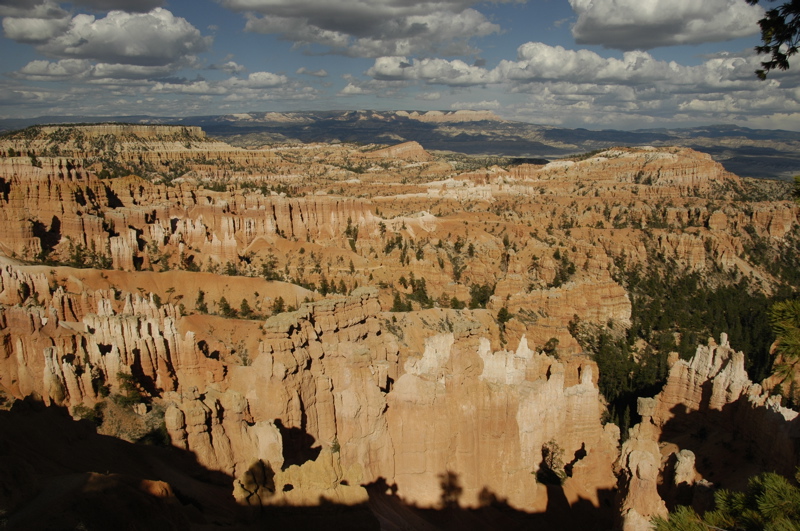
In Zion, you are in the bottom of the canyon looking (and hiking) up. In Bryce, you are on a narrow ridge that defines one edge of a valley, and all the hikes go down. It’s more like Grand Canyon in that respect, but the valley (they call it a canyon) is not as well defined on the opposite side. The best viewing is in sunny conditions, especially as the sun is rising or setting.
 One popular ranger-led activity is pictured at right. Care to guess what it is?
One popular ranger-led activity is pictured at right. Care to guess what it is?
Tree-sniffing! The bark of the Ponderosa Pines sometimes has a distinct odor like butterscotch, if you’re willing to press your nose to one and take a big sniff. Being able to watch this is one of the upsides of having crowds in the park.
Part of the reason the park is still so busy is that the season is very short. The park had its last snow in mid-June, and temperatures began to go below freezing at night in mid-August. Days are warm right now, but storms are frequent and the lightning is really dangerous. People stand out on the exposed ridges and get zapped at the rate of about one person every other year. We got chased off Rainbow Point by an approaching line of showers and high winds while we were observing a 1,600 year-old Bristlecone Pine tree. With the constantly-changing weather (and a bit of laziness), we were only able to hike about three miles all day.
 After two nights, we are being forced out by an incoming tour. The campground we are staying in can’t accommodate us any longer, and the national park campgrounds are still very full. Weighing the options, we’ve decided to leave Bryce Canyon and head south to Kanab for a few days. We are booked into the North Rim of the Grand Canyon starting on Wednesday, so we have a few days to get ahead on work, and make some side trips. But since it is only about 80 miles to Kanab, we will take advantage of Bryce’s shuttle system to have one last hike. We’ll park the Airstream in the large shuttle parking lot, hike the Queen’s Garden/Mojave trail (2.9 miles), and then proceed south to Kanab.
After two nights, we are being forced out by an incoming tour. The campground we are staying in can’t accommodate us any longer, and the national park campgrounds are still very full. Weighing the options, we’ve decided to leave Bryce Canyon and head south to Kanab for a few days. We are booked into the North Rim of the Grand Canyon starting on Wednesday, so we have a few days to get ahead on work, and make some side trips. But since it is only about 80 miles to Kanab, we will take advantage of Bryce’s shuttle system to have one last hike. We’ll park the Airstream in the large shuttle parking lot, hike the Queen’s Garden/Mojave trail (2.9 miles), and then proceed south to Kanab.
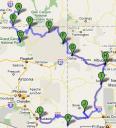 Also, we have confirmed that we will be going to the Albuquerque Balloon Festival Oct 3-6. This is a major detour east, but it will allow us to visit several other national park sites and explore some of so-called “Indian Country” (mostly the Navajo reservation but also passing by the Hopi, Zuni and several other tribal territories). See approximate trip plan at right — click to enlarge. We’ll go past Monument Valley, spend a few nights in Gallup, drop by some national monuments in New Mexico, and then go check out a few sights in southern New Mexico before heading to Tucson. At this rate, we’ll be back to winter home base in mid-October, just in time for the nice weather down there.
Also, we have confirmed that we will be going to the Albuquerque Balloon Festival Oct 3-6. This is a major detour east, but it will allow us to visit several other national park sites and explore some of so-called “Indian Country” (mostly the Navajo reservation but also passing by the Hopi, Zuni and several other tribal territories). See approximate trip plan at right — click to enlarge. We’ll go past Monument Valley, spend a few nights in Gallup, drop by some national monuments in New Mexico, and then go check out a few sights in southern New Mexico before heading to Tucson. At this rate, we’ll be back to winter home base in mid-October, just in time for the nice weather down there.
September 10, 2008 at 7:28 am · Filed under Travel / lifestyle musings
Bryce is at over 8000 ft elevation, something to keep in mind if you visit here. It may not seem like a large difference from the other parts of the Colorado Plateau, but it has made an enormous difference since we got here. In Capitol Reef every day was in the mid-80s, and nights were so comfortable that we slept with the roof vents open. But that was at 5400 ft, and a cold front has moved in as well. This morning at Bryce Canyon I woke up before dawn to find the outside temperature at 30 degrees, and the furnace cycling on and off every 10-15 minutes.
The furnace is kind of noisy when it runs, and it gets annoying when it is cycling a lot. It also is a greedy consumer of propane, so I got out of bed and fired up the catalytic heater to see how it would fare with the cold. The catalytic is virtually silent and 100% efficient, so it uses less fuel. We’ve run it a few times this year, but never in such chilly temperatures. Since it has a maximum output of 9000 btus (compared to 30,000 btus for the furnace), I was interested to see how it would do.
Well, the results are in: at full bore, with 30 degrees outside, the catalytic heater is just enough to keep the trailer at about 60 degrees. The middle of the trailer gets warmer than the ends, since the heat has to passively convect through the trailer on air currents, but it’s not bad at all.
Being up this early, and having silenced the furnace, I have been able to listen for sounds from outside. No coyotes howling here, or bugling elk, or even chirping crickets. Instead, I’m surprised at the amount of car traffic I can hear heading into the park at 6:30. People must be starting early for all-day hikes into the canyon.
At 6 a.m. I was treated to a classic “stupid camper trick.” Someone two sites away fired up their generator. After about a minute of running rather loudly, it shut off, and I presumed that they realized their mistake. There’s no need to run a generator in a full-hookup campground with 30-amp power at every site. But no, the motorhome user tried again a couple of minutes later. After three tries to get the generator started, it fired up again and ran for several minutes more in the pre-dawn darkness. This is the sort of thing that ensures your neighbors will not be friendly in the morning.
I can’t imagine any legitimate reason for running the generator under these conditions. My guess is that when I see the motorhome later this morning it will be bearing the giant labels of a rental. They are everywhere right now: big white box Class C motorhomes emblazoned with “ROADBEARRV” or “Cruise America” or “Moturis” or “El Monte RV”. Inevitably, this time of year, they are being driven by European tourists who have come over to take advantage of the weak US dollar, the lack of crowds in the school season, and the endless beauty of America’s western national parks.
They also love the fact that our fuel is only $4 a gallon, compared to the $10 they are used to paying back home, and who wouldn’t love the fall weather? I’m glad people in other countries recognize that the American southwest is one of the most incredible places in the world. They seem to really appreciate being here.
Most of these folks are British or German, but I heard more foreign languages while at Capitol Reef than I think I’d hear in an afternoon at the United Nations. They seem to have some experience with driving motorhomes so they aren’t always terrifying, but I still always watch carefully when one comes down the road. I think they should paint the rental RVs yellow or orange, like rental trucks, so that people can immediately know that there’s quite possibly a clueless newbie driving that huge box.
The sun is still below the horizon but there’s some light in the sky now, and I can see the motorhome in question from my window. Yep, it says “Cruise America” all over it. From his dress, the occupant appears to be American. He has clothes hanging from the radio antenna, and at 7 a.m. he is taking down a clothesline strung from the passenger’s rear-view mirror to a tree on our site. He is hustling to get packed up, like a tornado is coming. Doors are banging open and shut every minute or so, and various thumps are emanating from the interior. When outside, he is storming back and forth and shaking his hands from the cold. Maybe he’s in danger of paying for another day, and wants to get back to the rental office soon.
I would hate to count the number of breaches of RV etiquette that I see and hear being committed next door. Fortunately, I was already awake, and I’m not a stickler for etiquette anyway. Mostly it’s an amusing show that reminds me of when we got our first Airstream and had to learn the ropes.
I’d hate to learn on a rental RV. One of the first things I noticed about having a travel trailer is that everything is highly personalized. There’s no single “right way” to do everything. You have to work out your own systems, your own storage methods, your own checklists, and get to know your equipment. You can’t do that with a rental because you can’t personalize it. With our own trailer, when I spotted a problem, I could modify things to work better. It’s like having your own apartment versus living in a motel. It’s fine for a short time, but over the long run you want your own stuff.
At this point we have our trailer so thoroughly tweaked and tricked out that it’s hard to imagine being in another. Everything is the way we need it to be, which is probably why we feel so comfortable in it. The catalytic heater is just the latest example. I like the fact that we have our home equipped “just so.”
The Cruise America motorhome has now departed, after several minutes of idling in the campsite and much revving of the engine. We won’t miss him. Things are quiet again. Eleanor is up with the sun, making coffee in the kitchen, and I think this cold morning calls for hot cereal and tea for me. We’ll have a few minutes of time to ourselves before Emma wakes up, and then start planning a day out in Bryce Canyon.
« Previous entries ·
Next entries »
 Today in the grocery store, in Kanab UT, Eleanor discovered treacle in a can.
Today in the grocery store, in Kanab UT, Eleanor discovered treacle in a can.













